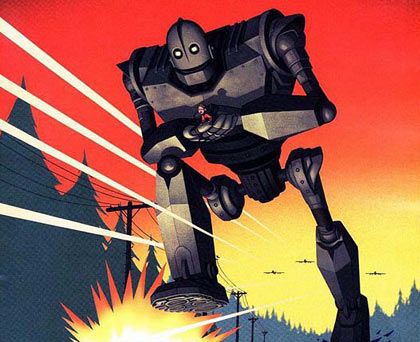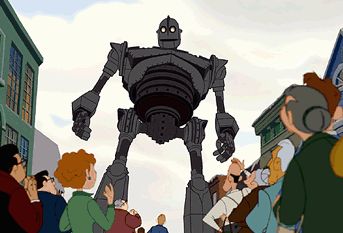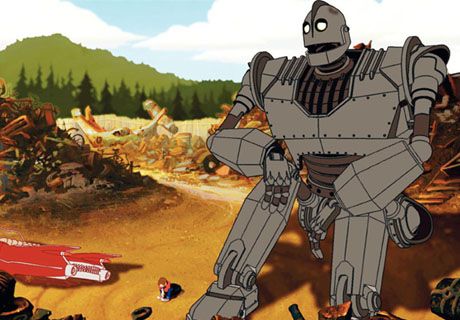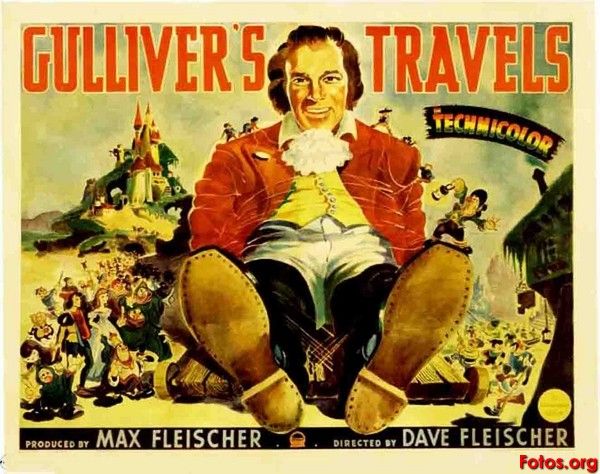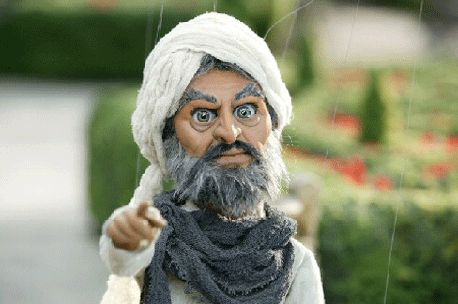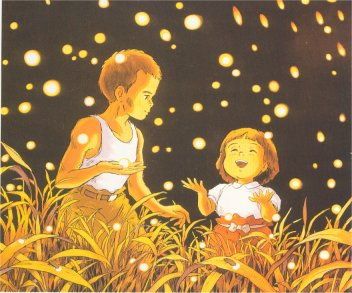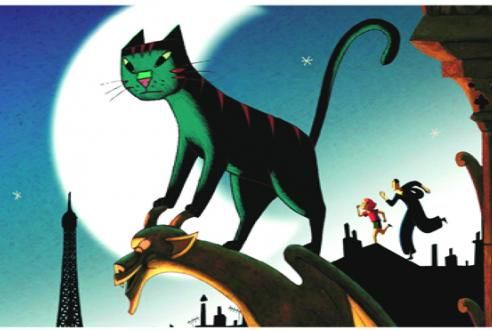This week, the Regent Showcase hosted the 3rd Annual Los Angeles Animation Film Festival. The four-day fest boasted 35mm screenings of The Iron Giant, Gulliver’s Travels, Team America, Grave of the Fireflies and A Cat in Paris, amongst many others. For a full rundown of just what screened and when check out the festival’s website. For select highlights from days two through four of the fest, hit the jump. For further coverage of the fest – see here.
The Iron Giant
“I am not a gun.†The simple motto perfectly encapsulates Brad Bird’s seminal masterpiece The Iron Giant. Critically adored upon release, The Iron Giant has only grown in repute since 1999. As presenter/Animation Director Tom Sito noted pre-screening “Iron Giant may be the only film that when the lights come up it’s all the guys in tears.†Even star Eli Marienthal (only thirteen when he voiced Hogarth Hughes) waxed nostalgia – describing the film as the “proudest thing he’s ever done†and a “cry for peace†every bit as relevant today as it was thirteen years ago.
Highlights from The Iron Giant Post Screening Q&A
Participants: Director Brad Bird, Star Eli Marienthal, Production Designer Mark Whiting, Art Director Alan Bodner, Story Board Artist Steve Markowski, CGI Animator Brad Booker, Animator Eddie Rosas, and CG Supervisor Tad Gielow
The Development of The Iron Giant
Bird was stuck in a development deal at Turner that was proving less than fruitful (he jokingly referred to his time there as ‘Turner Suspended Animation’). When Warner swallowed up Turner – they also took up the remaining years of Bird’s contract and gave him the pick of forty or so projects in the earliest stages of development. Of the offers, the book The Iron Giant stood out. The book opens with a young boy discovering an interstellar being made of metal.
Over time a friendship grows between the two; however the book veers off from that initial relationship making way for a rival alien dragon that the Giant must defeat. Bird said these developments in the book didn’t interest him as much as the basic interpersonal story of a boy and his best friend: the Iron Man.
When pitching The Iron Giant to Warner executives, Bird summarized the film thusly ‘what if a gun had a soul and didn’t want to be a gun anymore.’ This simple logline/what-if-scenario piqued the executive’s interest. Bird, so energized by the material, actually pitched the entire film to the room – the 1950’s setting, the CIA baddies, the single mother, the scrapyard art, etc.…
Bird regaled that midway through the pitch one of the executives demanded he stop so someone could take notes on the remainder of the story. He took this to be indicative of a successful meeting. Later Bird confided – he discovered that these pitch notes were being used to formulate a script behind his back. Thankfully Bird had already registered the pitch with the WGA and this ‘alternative take’ was quickly squashed.
Designing the Giant
The earliest designs of The Iron Giant, per Bird, had the Giant with human characteristics – lips and a tongue, for instance. Bird asked his friend Joe Johnston to come up with a more metallic and industrial looking being. These earliest drawings proved to be the blueprint for The Iron Giant. From here, Mark Whiting came on board – and hammered in the “nuances†of the creature, roughening up its facial features and body. Whiting stated he wanted the Giant to look “clunky and lived in - Ape-likeâ€. And so the final iteration of the Iron Giant was born – dented forehead, protruding nails, rawboned body and all.
Controversy/Interference on the Film
Bird stated that initially there was hesitation on the studio’s part to whether an animated film could have a child get chloroformed; but the main source of trepidation concerned the film’s ending. At the climax of Iron Giant, a bomb threatens to destroy the town of Rockwell. Bird remembered a meeting – wherein executives questioned whether the bomb was atomic and if it was an atomic bomb would that be appropriate for a children’s film. Bird maintained that it was not an atomic bomb but a ballistic missile. For some odd reason, his semantics fooled the room. An atomic bomb = Not OK for a kid’s film. A Ballistic Missile = Ehhh… whatever. Bird joked that he just tried to make the film as quickly as possible “before they figured out what [he was] doingâ€.
On Traditional 2D Animation
As CG Supervisor Ted Gielow informed: The Iron Giant is actually a “marriage between 2D and 3D animation†The trick was to make the 3D animation look like “pencil work when it was done.â€
Bird said that he would love to work within the template of 2D traditional animation again, but lamented that no one’s “putting big bucks into itâ€. He drew the comparison of jazz to classical music – and that all forms of music (read animation) are of equal use.
Gulliver’s Travels
The 2nd US animated feature*, Dave Fleischer’s Gulliver’s Travels (1939) feels a little stuffy and outdated in the modern light. The picture, barely seventy-five minutes, feels a whole lot longer than its runtime. This can perhaps be accounted to the film’s odd structure – for the first thirty or so minutes Gulliver remains unconscious as little tiny people attempt to tie him up. The whole thing seems to play in real time – as we watch the tiny peoples of Lilliput rope up the giant’s legs, his arms, his torso – then put him onto a stretcher, then wheel him to the city. After awhile it becomes more than tiresome. But the animation itself remains positively beautiful. The 2D cells look exceptional especially projected up on the big screen from a 35mm print. And the music – “We’re All Together Now†and “It’s a Hap-Hap-Happy Day†are more than hummable. If content wise Gulliver’s Travels hasn’t aged well, then at least aesthetically it remains as breathtaking (if not more) today as it was on release. It’s a nice reminder to the power of traditional hand drawn animation – a thing, which has become increasingly neglected and rare nowadays.
*…Or 3rd as noted by animation historian Jerry Beck. Snow White is often thought of as the first animated film – but a year prior Disney released a collection of short animations as a feature, making Snow White actually the 2nd animated movie. This, of course, does not account for the numerous foreign animated films made prior to Snow White and Gulliver’s Travels.
Team America
Yep – still pretty funny.
A number of the voice cast and puppeteers were on hand to discuss their experiences on the crazy set. Bullet point highlights below:
- Participants: Phil Hendrie (voice of I.N.T.E.L.L.I.G.E.N.C.E.), Daran Norris (Spottswoode), puppeteers Steve & Ed Chiodo
- Norris stated that he only auditioned for the voice of Spottswoode while Hendrie countered that he was asked to audition for multiple voices but ended up only doing I.N.T.E.L.L.I.G.E.N.C.E (+ a couple of terrorists). Parker did most of the voices on set with the intention of getting someone else to replace them later. But after hearing himself doing the voices whilst editing, Parker decided just to keep his own “shitty interpretationsâ€.
- Hendrie stated the movie was pitched to him as a “serious puppet filmâ€. Per Stone/Parker (who although not present were talked of frequently and in the highest esteem) – “puppets doing funny stuff isn’t funny; but puppets doing serious things is HILLARIOUS.
- The genesis of Team America: “What if we shot the script to Armageddon… but with puppets?â€
- On the infamous sex scene: Steve Chiodo confided that one of the puppeteers refused to participate in the golden shower/shit scene – so he gleefully volunteered to do it. Chiodo also revealed that the shit was a mashed up tootsie roll.
- On why there aren’t more puppet films: the Chiodo brothers relented that puppets are actually much more expensive than just hiring actors – so the puppet-film market will always be niche. Norrie chimed in that originally Parker/Stone wanted to do a film with only puppets because they hate actors and don’t ever want to work with them; but after their experience on Team America – they stated they would never work with puppets ever again.
- There will never be a sequel - per the cast.
- Making Team America was highly improvisational. The script was constantly changing and being rewritten on a day-by-day basis.  For example: Ed Chiodo noted that the design of the Matt Damon puppet didn’t look particularly good and didn’t resemble the actor in the slightest. Upon seeing the puppet, Parker noted how fucking retarded the puppet looked – which gave him the idea to play Matt Damon full retard. And so “Matt Damon†was born on the spot.
Grave of the Fireflies
Well known as being possibly the saddest animated film of all time, Isao Takahata’s World War II set tragedy opens with a young boy starving to death on a train platform whilst commuters pass him by – and then somehow gets even more depressing from there. The film flashes back to the middle of War World II, as the same boy (14 year old Seita) and his 4-year old sister Setsuko flee to an underground bomb shelter with their mother in tow. However – the mother dies in the confusion, leaving the two kids on their own. From there the two attempt to survive – at first with a negligent and manipulative aunt and then on their own in the extensive backyard of an unoccupied home. Things do not go well. Ostensibly - Grave of the Fireflies depicts two kids slowly starving to death; but the film doesn’t wallow in such depressing subject matter. In fact (and maybe this is why the picture is so effective) Grave of The Fireflies is downright beautiful to look at. Up on the big screen, the 2D animation has never looked as crisp and clean, shot as if it were a rose-tinted memory; that what’s actually happening is horrifying juxtaposes nicely with the nostalgic aesthetic. A must see for all animation enthusiasts.
A Cat in Paris
Sporadically amusing but tonally confused, the 2011 Animated Film Oscar nominee doesn’t live up to the pedigree. The titular cat is pretty awesome though – as is the initial premise: a lazy cat of a police officer’s daughter doubles at night as a “cat burglar†(I couldn’t resist). Unfortunately the movie doesn’t stick with the cat robber angle – instead substituting it for a bunch of bumbling gangsters and a kidnapping/girl-in-peril/rescue plotline. The cat becomes a side character in his own film, more time being spent with the young girl and her police officer mother and the gangsters and a human male thief accomplice. Also the movie can’t quite settle on a tone – the stuff with the cat and the bumbling gangsters is fairly light hearted – but a subplot involving the policewoman avenging the murder of her husband feels dark especially in light of all these comedic beats. A disappointing misfire.
Special mention must be given to Keichi Tanaami’s great “flower†shorts, which preceded many of the animated films (his shorts were selected by artistic director Sean Lennon). Here’s a clip from his Fetish Doll:
I’ll close out my coverage of The 3rd Annual Los Angeles Animation Film Festival – with a look at quite possibly my favorite in-competition animated short from the fest – Zombie Dragonfly Discotheque:


